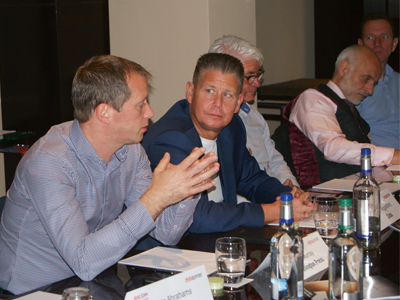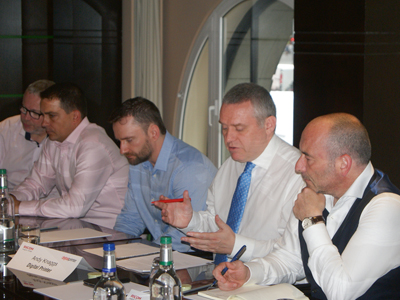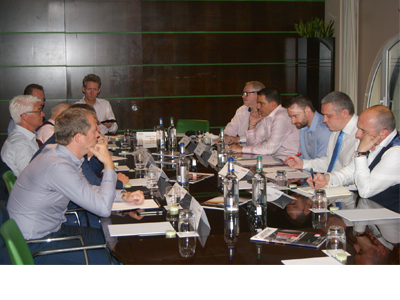Andy Knaggs (second from right) chaired the roundtable, held at One Aldwych, London
At a roundtable at the end of June, print business owners discussed the challenges from the increasingly wide range of ages in the UK workforce. Andy Knaggs reports.
In 2014, the UK Commission for Employment and Skills (UKCES) published a study that looked at the likely makeup of the British workforce by 2030. One of its key findings was that an ageing population will create four-generation or ‘4G’ offices, where staff in their 70s and 80s work alongside those in their late teens and 20s. It predicted that the number of economically active over-65s will grow by a third in that time frame.
More recently, Ricoh Europe sponsored a further report on the subject in 2015, conducted by Coleman Parkes Research, which revealed how businesses are struggling to accommodate the four generations (Baby Boomers, Generation X, Millennials and the emerging Generation Z). It found that more than half of those surveyed (52 per cent) said that their companies were failing to cater for the needs of a multi-generational workforce.
It also found differences in the expectations that these generations have of the company for which they work. Generation Z, for example, have higher workplace expectations than older groups, and they will become more quickly frustrated too. Salary aside, this younger generation see work-life balance and working with great people as being more important than job security, while this last factor is front-of-mind for Baby Boomers.
Scarce resources
Digital Printer brought together a selection of print directors to discuss how our industry is managing the issues that can arise from a 4G workforce.

Clockwise from top left:
Alan Rigglesford, managing director, Clicks Print; David Sharpe, operations director, Twist Print & Design; Lee Deeks, operations director, Passion Print; Nick Murray, managing director, Wellington Press; Simon Tabelin,managing director, It Has To Be Brilliant; Tony Kenton, marketing director, It Has To be Brilliant
The discussion that ensued took the panel into an area in which few were well-versed: Human Resources. In fact, only Brilliant of the companies present could really claim to have any formal approach to HR issues. It runs what is very much a corporate-type model for staff engagement, as Tony Kenton explained: ‘We have a full time person doing HR, and not a single day goes by without us looking at things like Ts & Cs and training. We review everyone in the company at least twice a year, looking at KPIs (Key performance indicators) and personal development. We don’t approach it as in-your-face HR. We say, next year this is what is achievable, are there any obstacles? Some people want to take a bit more holiday, some people want driving lessons on the company. Different things motivate different people. We set out to grow a corporate business so we need to have a corporate style. Everyone that comes in has to have a corporate approach of systemising everything. That was our philosophy from Day One.’
Lest hearing such words makes readers shake their heads in dismay at the paucity of their own HR efforts, it is worth noting that Brilliant is not your average print company but more of an agency operator these days. Perhaps more akin to the common experience might be the input from Nick Murray, who said: ‘I get pulled up by our ISO guy about staff appraisals. He says, “you have a legal responsibility to do all this”, and I do it. But because we are quite small and I know people well, often an appraisal becomes part of a general chat.’
Young & old
What of the multi-generational workforce though? It is certainly nothing new to have both young and old within a team, and many might maintain that it is advisable, at the very least for the future health of the company. Lee Deeks stressed the need to have a range of skills and expertise in-house, but acknowledged that with a complicated job ‘the knowledge of the older guys really comes in’. Is there a difference in general workplace outlook though, between a younger and older person? It can become apparent right at the interview process, said Tony Kenton:
‘We have had to have a change of mindset when interviewing people. They are saying they want to stay for three or four years. You used to think if they didn’t want to work for you forever they were not committed. We have to come to terms with that mindset.’
This can have implications for a company’s commitment to training its staff. One argument sometimes made by managers is why invest in your people if they intend to leave in the near future and deploy their new-found skills for the benefit of another company? A retort to that is what if you don’t invest in training staff and they stay? From the staff’s perspective however: why would they stay at a company that is not prepared to support their development? What is needed in that situation is trust.
The UK’s obsession with a university degree over many years, arms young people with certain expectations from their career, observed Dave Sharpe: ‘They may have been to uni and expect a higher end, better-paid job. They are looking for something better to do. I had to be a messenger when I left school.’
Alan Rigglesford agreed with this, saying: ‘You start at the bottom and work up, getting experience. When you’ve got a law degree you don’t want to start at the bottom.’
Nick Murray added that ‘if you don’t get a pretty good job, you are staring at (owing) a massive amount of money that might hold you back’. However, Tony Kenton made the point that the conversation was assuming that the majority of roles in the printing industry are ‘blue collar workers’. He said: ‘The people we are managing have a degree, but they are analysts, Big Data people. Less than 30% of our team are typical blue collar.’
It served as a reminder that people cannot just be categorised by their age, something that the panel would return to in their final musings, where it was very much the view that in general you should not manage an individual based upon their age – everyone in the team should be treated equally.
Middle matters
At the mid-point of the discussion however, it had very much been the case that thoughts and observations had revolved around young and old employees and theories around their different expectations of work and their relative utility to the business. Now another dynamic was introduced: that of what might be termed ‘mid-career’ employees; more mature and capable staff that in many respects are the engine of the company’s success. Do these need particular management care and attention?

Nick Murray and Alan Rigglesford shared ideas on how to manage ‘mid-career’ employees
‘When someone like that presents a problem, you go and deal with it,’ said Alan Rigglesford. ‘You trust them to do their job and be mature enough to not cause you issues. They might have problems, such as a divorce, that you need to keep in mind.’
The question gave Nick Murray pause for thought. It touched very closely upon a real-life situation for him. ‘Those guys do a good job. It’s a valid point that I need to think about at length. You think they are plodding along and then someone is away and they step up to fill that gap. You do need to find a way to step in and motivate that person to do more. Your point really hits home for me.’
There was a different perspective on this from Tony Kenton, who reflected that ‘what we are measuring is that people take on responsibility. He continued: ‘Rather than mid-career, it’s middle-management level. We have had young people come in that have taken on responsibility – real go-getters – and those are the people we need to keep. Others may be doing nothing when mid-career, according to the time frame. The reality is, are they junior, medium or senior management? We have an exit strategy from the top down, so the mid people know when we are moving on and they can step up. That gives them a real spur and they potentially will have a stake holding too.’
Simon Tabelin added that this outlook was ‘part of the structure’ at Brilliant: ‘We are looking after them.’ He also put forward the opinion that everyone is driven by different motivations, and these are not necessarily shaped by their age, to which Nick Murray responded that in a 4G print business there may be practical issues for staff as they get older. He said: ‘Lugging paper into a guillotine can be hard work at 72 years old. No one has taken that into account – that there will be this point with the older generation that we are going to have to deal with as employers.’ He highlighted that older staff have irreplaceable skills and knowledge that is valuable even if some physical tasks could be problematic.
Support for 4G
The panellists discussed where they turn to within the print industry for help with any issues that might arise from a 4G workplace. ‘You need to prompt a conversation with someone like the BPIF,’ said Alan Rigglesford.
‘That’s what we have always done,’ agreed Dave Sharpe. ‘They do help with HR guidance and training for staff.’
The subject of apprenticeships was raised, but experiences do not seem to have been good, partly through the red tape involved, and partly through what seems, from the anecdotes expressed, a somewhat lackadaisical attitude from the prospective apprentices themselves.

Simon Tabelin (far right) employs a full-time HR staff member at It Has To Be Brilliant and advocates treating the entire workforce equally
Ultimately, the general view was that expressed by Nick Murray as ‘age should not be how you look at your workforce’, and by Simon Tabelin as ‘they all get treated exactly the same, there’s no special treatment’. Within that come motivational approaches, ranging from Brilliant’s HR prowess and succession planning, to the ‘old school’ way, as articulated by Lee Deeks: ‘We take the staff out frequently. What you put in, you get back out.’
Tony Kenton provided another perspective that seems an apt way to close. The basis of motivation is appreciation, he said, encouraging employees to believe they can make a big difference. However, ‘the new way of developing staff is nothing to do with taking them out socially, or the paper- work involved in apprenticeships; it’s social media. They are looking constantly at Facebook or Twitter, and getting their information from that source. I suggest, just take into account what’s being broadcast, because your team is reading that.
‘We are learning lessons that they are very savvy on social media. A big growth area is in the 50+ age group and social media, so it’s not just the young. Here is a unifying thing that we can manage and use to reach our staff better.’





